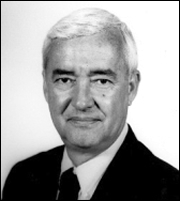
Curiosity about, even fascination with, the institution of the papacy is understandably widespread during these days between the death of Pope John Paul II and the opening of the conclave which will elect his successor.
During this period, the redoubtable Lawrence S. Cunningham, John A. O’Brien Professor of Theology at Notre Dame, has been busy answering questions from journalists all over the world, and from the staff of the University’s news and information office.
The author of some 20 books and countless scholarly and popular articles on the Church, its theology, its history, its people, and its saints, Cunningham recently recounted some anomalous conclaves of the past:
- With only 10 cardinals in attendance (the other two were prisoners of Emperor Frederick II), the squabbling prelates, after 60 days shut up by order of the civil ruler of the city in a malodorous palace in Rome, finally elected Celestine IV on Oct. 25, 1241. The new pope, in wretched health, died Nov. 10 of the same year without having ever performed any papal function. His 15-day reign still holds the record for the shortest papacy in history. Due to political upheavals the next pope (Innocent IV) was not elected until 18 months later.
- After the death of Honorius IV in 1287, the cardinals, hopelessly divided in a conclave that dragged on for 11 months, finally elected a Franciscan friar who refused the honor, only to be elected again in a desperate attempt to end the conclave (six cardinals died from the Roman heat in their meetings). He then reluctantly accepted and took the name Nicholas IV. After his death in 1292, the cardinals again deadlocked for nearly 28 months until they finally dragged an 85- year-old hermit, Pietro del Morrone, from his solitary life and made him pope. Taking the name Celestine V, he resigned the papacy five months later thus earning him a place at the entrance of Dante’s Inferno for having made, in Dante’s words, the “great refusal.” In 1313 he was canonized a saint by Clement V under pressure from Philip IV of France, who wanted to thus provide payback to Celestine’s successor, Boniface VIII, who, in the emperor’s eyes, was his chief antagonist.
- The last time an emperor attempted to veto a papal election was in 1903, when Emperor Franz Joseph ofAustriaannounced a veto against the former cardinal secretary of state (Rampolla), who was the alleged favorite going into the conclave. The cardinals, in fact, elected Giuseppe Sarto, who took the name Pius X and is the last pope canonized a saint.
- In 1831, after a 50-day conclave, the cardinals elected a Camaldolese monk as pope. Hetook the name Gregory XVI and is the last monk to have been elected to the chair of Peter. A thoroughgoing reactionary who refused to allow railroads to be built in the papal states, he is best remembered today for his founding the Etruscan and Egyptian museums in theVatican.
- Until the 8th century, the pope was elected by the laity and clergy of the city ofRome. In the 11th century the cardinal bishops nominated the pope but the decision then had to be ratified by the Roman clergy. The ratification process soon was eliminated and the procedure became similar to what currently is in place.
TopicID: 10724